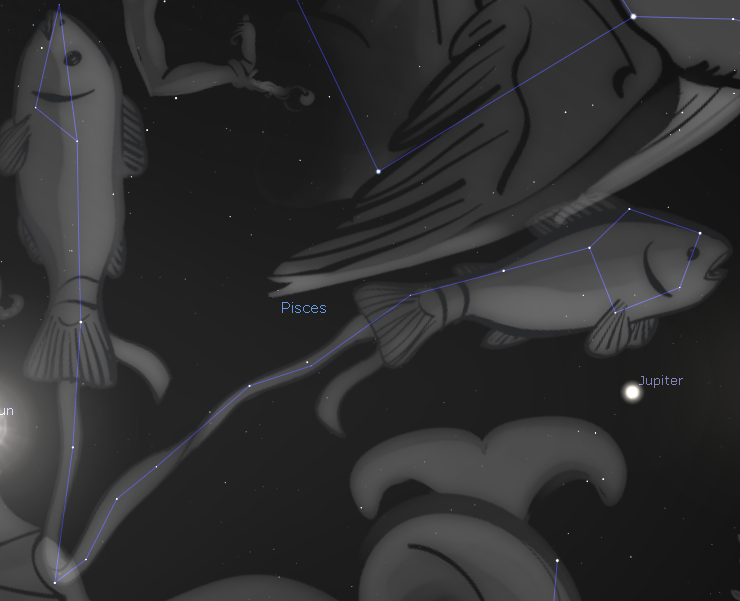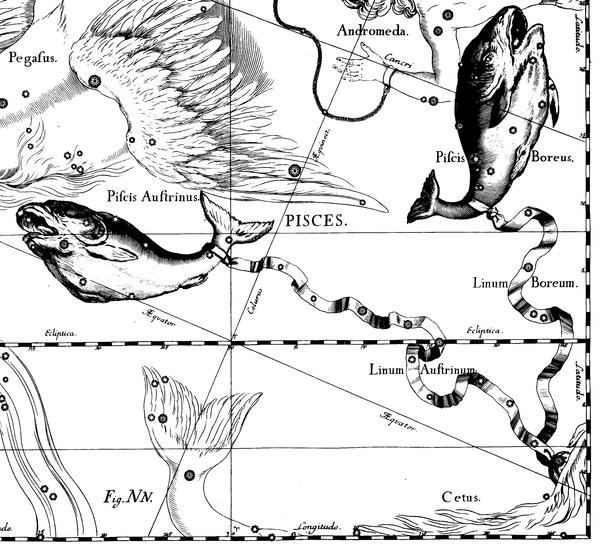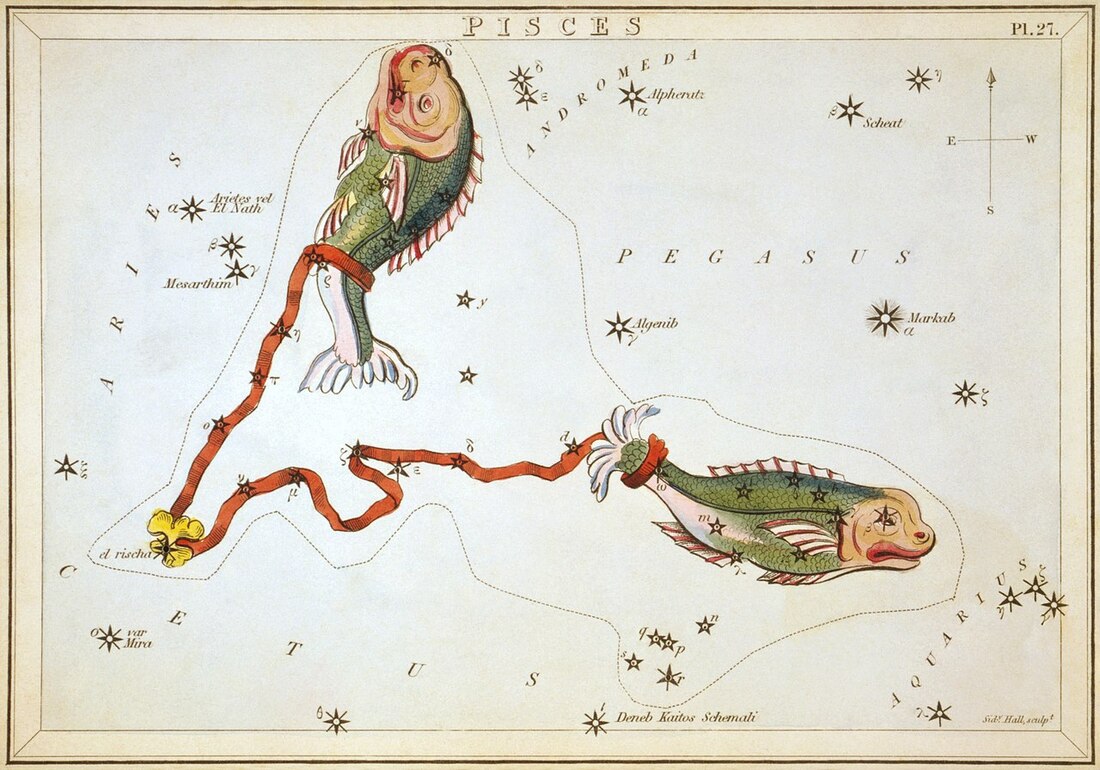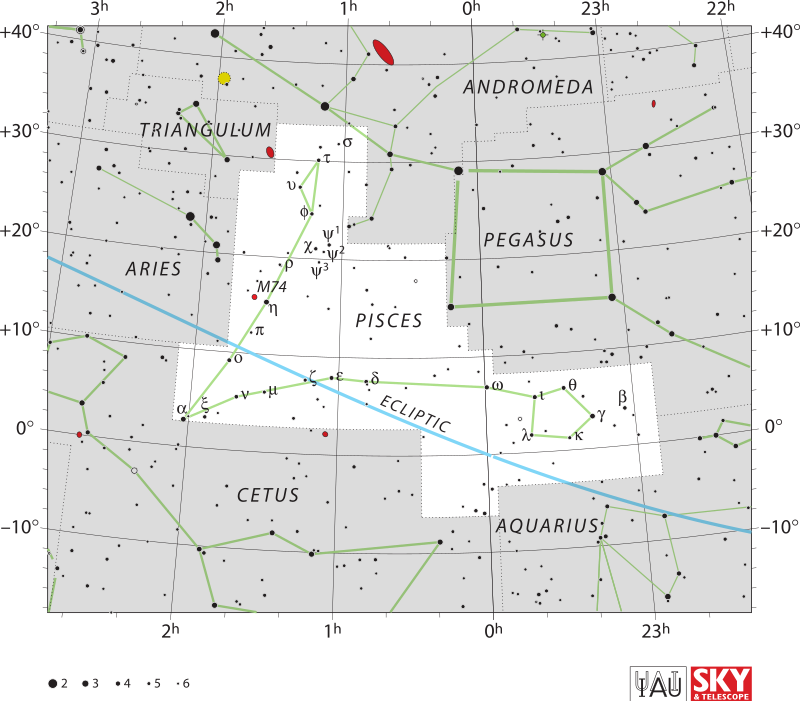|
A zodiacal constellation is Pisces. Its enormous bulk is in the Northern Celestial Hemisphere, as is its major asterism, which most European cultures interpret as a far-off pair of fish connected by one string each and joining at an apex in Greco-Roman antiquity. Pisces is its ancient astronomical symbol (♓︎). "Fishes" is what its name in Latin means. It is between the comparable-sized Aquarius in the southwest and the diminutive Aries in the east. Within this constellation and in Virgo, the celestial equator and ecliptic meet. This indicates that, on average, at the March equinox, the sun rises and sets approximately at this location in the sky.
|
|
History and Mythology
Pisces derives from a combination of the Babylonian constellations Anunitum, the "Lady of the Heavens" (reputedly Inanna), near the location of the northern fish, and Inunutu4, "the big swallow," in the western Pisces of today. Part of the constellation was also referred to as DU.NU.NU in documents from the first millennium BC known as the Astronomical Diaries (Rikis-nu. mi, "the fish cord or ribbon"). Greco-Roman era The Greek myth of Aphrodite and her son Eros, who either transformed into fishes to flee or were saved by two fishes, is connected to the sign of Pisces. According to Hyginus, in the Greek account, Aphrodite and Eros fled the monster Typhon when touring Syria by leaping into the Euphrates River and turning into fishes (Poeticon astronomicon 2.30, citing Diognetus Erythraeus). (Hard 2015) Venus and Cupid, the Roman counterparts of Aphrodite and Eros, are carried away from this threat on the backs of two fishes in the Roman version of the narrative (Ovid Fasti 2.457ff). (Hard 2015) Hyginus also retained a separate genesis story in different works. According to legend, a dove sat on an egg until Aphrodite (later referred to as the Syrian Goddess) emerged from it after an egg rolled into the Euphrates and was nudged to shore by some fish. The fishes were later honoured by being designated as a constellation in the sky (Fabulae 197). (Ridpath 1988) The Third Vatican Mythographer also has a description of this tale. (Van Berg 1972) Modern era The astronomer Johannes Hevelius identified four subgroups within the constellation Pisces in his Firmamentum Sobiescianum from 1690: "Piscis Austrinus" is more frequently used to refer to a distinct constellation in and of itself. Astronomer John Hill (author) suggested in 1754 designating a portion of Pisces' southern zone as Testudo (the Turtle). It would contain a naturally occurring but very faint asterism in which the star 20 Psc is the head of the turtle. (Allen 1963) 24 - 27 - YY(30) - 33 - 29 Psc. The concept was mentioned by Admiral Smyth, but other astronomers mainly ignored it, and it is now out of date. |
Western lore
The Fishes are mentioned in German folklore about Antenteh, who only had a tub and a basic cabin when he first encountered two supernatural fish. He declined their offer to grant him a wish. His wife pleaded with him to go back to the fish and request a lovely home, though. Her wish was achieved, but she still had unmet wants. The fish were enraged and stole the palace and home when she begged to become a goddess, leaving the couple with the tub and cabin once more. She then asked to be a queen and have a palace. The Great Square of Pegasus is sometimes recognised as the tub. (Staal 1988)
Non-western astronomy
In Chinese astrology, the stars of Pisces were combined into several constellations. A barrier called Wai-ping, or "Outer Enclosure," prevented a pig farmer from falling into the marshes and kept the pigs in their proper place. Alpha, Delta, Epsilon, Zeta, Mu, Nu, and Xi Piscium all served as their representatives. The four stars known as Phi Ceti stood in for the wetlands. Koui-siou, the House of the Sandal, was represented by the northern Pisces fish. (Staal 1988)
The Fishes are mentioned in German folklore about Antenteh, who only had a tub and a basic cabin when he first encountered two supernatural fish. He declined their offer to grant him a wish. His wife pleaded with him to go back to the fish and request a lovely home, though. Her wish was achieved, but she still had unmet wants. The fish were enraged and stole the palace and home when she begged to become a goddess, leaving the couple with the tub and cabin once more. She then asked to be a queen and have a palace. The Great Square of Pegasus is sometimes recognised as the tub. (Staal 1988)
Non-western astronomy
In Chinese astrology, the stars of Pisces were combined into several constellations. A barrier called Wai-ping, or "Outer Enclosure," prevented a pig farmer from falling into the marshes and kept the pigs in their proper place. Alpha, Delta, Epsilon, Zeta, Mu, Nu, and Xi Piscium all served as their representatives. The four stars known as Phi Ceti stood in for the wetlands. Koui-siou, the House of the Sandal, was represented by the northern Pisces fish. (Staal 1988)
Deep-sky Objects
Messier 74 (M74) – Loosely wound spiral Galaxy (Type Sc)
NGC 488 – Prototypical Spiral Galaxy
NGC 520 – Colliding Galaxies
Main stars - 18
Bayer stars - 86
Stars with planets - 13
Stars brighter than magnitude 3.00 - 0
Stars within 32 Ly - 8
Messier objects - 1
Meteor showers
Bordering
constellations
Messier 74 (M74) – Loosely wound spiral Galaxy (Type Sc)
NGC 488 – Prototypical Spiral Galaxy
NGC 520 – Colliding Galaxies
Main stars - 18
Bayer stars - 86
Stars with planets - 13
Stars brighter than magnitude 3.00 - 0
Stars within 32 Ly - 8
Messier objects - 1
Meteor showers
- Piscids
Bordering
constellations
- Triangulum
- Andromeda
- Pegasus
- Aquarius
- Cetus
- Aries



